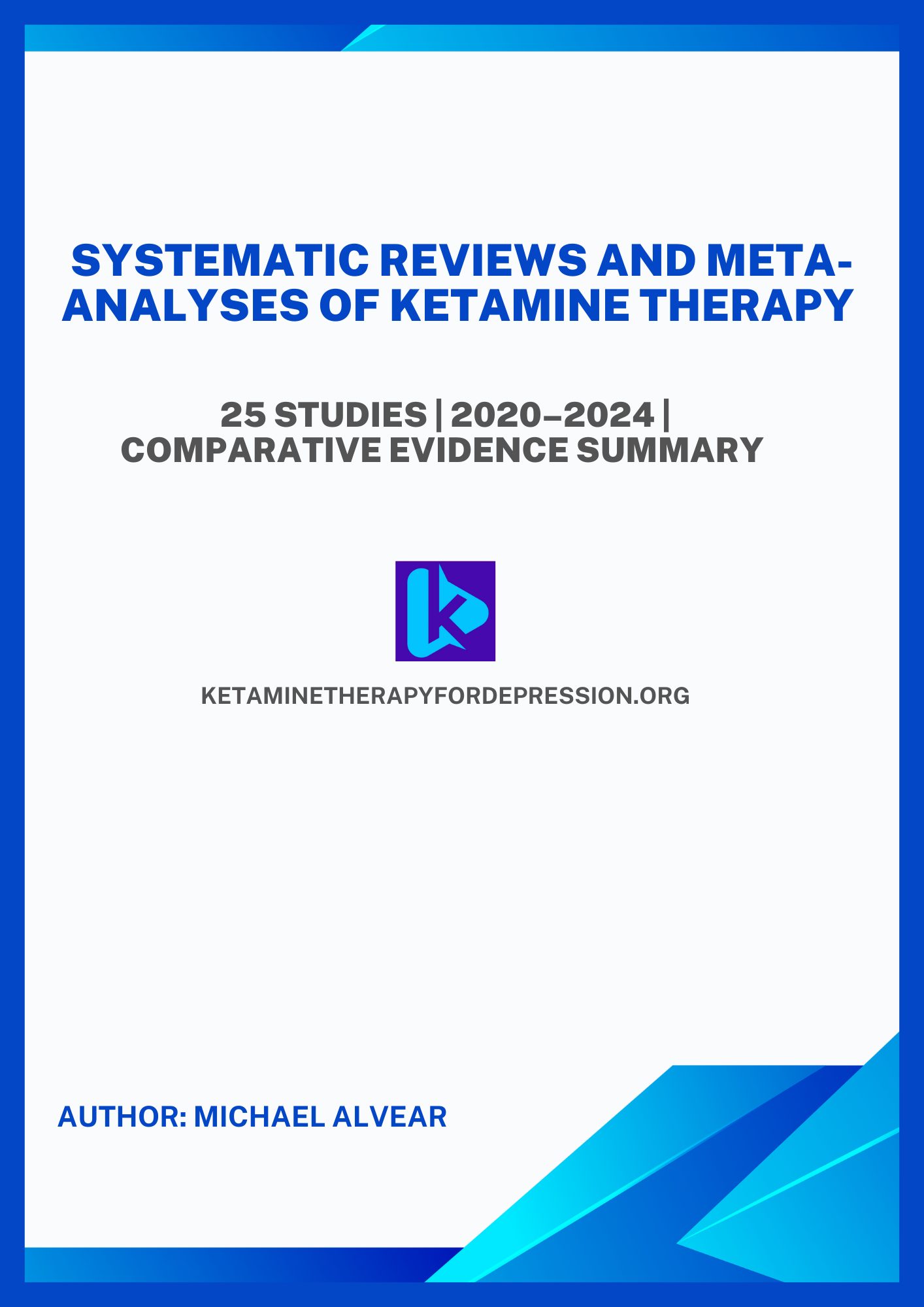By Michael Alvear, Health Author & Independent Researcher
My research is published on these scholarly platforms:
I was undergoing ketamine therapy for treatment-resistant depression—leaning back comfortably in a leather recliner, aware of the panic button on the table and a camera trained on my face. My doctor had described the process clinically, almost antiseptically. I expected something strange, maybe intense. But not this.
No one prepared me for the onslaught of psychedelic visions—or the gut-wrenching “flashbacks” that left me sobbing on and off for two days straight.
Why did nobody warn me about the intensity of the psychedelic visions I would have?
It felt as if the entire industry, from the scientists who study ketamine to Johnson & Johnson who invented the spray, to the FDA that approved it for use, and even the psychiatrists running the clinics, had agreed to keep me in the dark about what was coming.
Nowhere in any of the research papers, Spravato’s esketamine website, or the ketamine clinic websites I scoured was the word “psychedelic” ever mentioned. Even my own doctor focused strictly on the science—how ketamine acts rapidly on NMDA receptors, boosting glutamate release, enhancing synaptic connections, and promoting neuroplasticity to rebuild the brain’s architecture affected by depression.
The Word That Must Not Be Uttered
When she did finally mention It That Must Not Be Named, she phrased it so carefully and conservatively (“you might have dream-like experiences”) that it barely registered. Nothing in those understated words prepared me for the jolting, reality-warping ride that I experienced.
It was only later, when I dug deeper into the research and spoke with other patients, that I realized something important—not everyone experiences psychedelic visions, although most do. Around 50–75%, depending on dosage and method of administration (IV, nasal spray, etc.). The mind-altering effects exist on a spectrum. While most patients report being launched into vivid dreamscapes filled with geometric patterns and profound visions, others describe their sessions as more subtle—like floating in a warm bath or watching their thoughts drift by like clouds.
Several factors influence whether a patient encounters psychedelic effects. For starters, dosage plays a significant role—higher doses are more likely to induce psychedelic-like experiences. The treatment setting also matters: some clinics encourage the use of blindfolds or eye masks, which heighten internal visual experiences. But perhaps most important is individual variability. Each person’s neurochemistry and psychological makeup can profoundly shape their response to ketamine.
A Conspiracy of Silence? Or Strategic Omission?
The near silence about ketamine’s psychedelic effects wasn’t some oversight—it was a deliberate act, a strategic omission rooted in a messy mix of history, public perception, the threat of government sanctions and the loss of potential business.
The term “psychedelic” still sends a shiver through the medical and regulatory world. To the average person, it’s more about swirling colors and acid trips than serious mental health treatment. Scientists, researchers, psychiatrists and Johnson & Johnson, which developed the nasal spray, knew that any mention of visions or trippy experiences would sink their chances of getting ketamine into clinics and pharmacies.
So, they rebranded the drug as something purely clinical—a science-backed medicine for depression. No lava lamps, no incense, no talking about the realities of what might actually happen when you take it.
Even the FDA was in on this sanitized story. They weren’t looking to approve a psychedelic; they were signing off on a mental health treatment, something safe and clinical that doctors could get behind. The trials were set up to measure depression relief and risk reduction, not to delve into the hallucinatory detours patients might face along the way. The word “psychedelic” was scrubbed from every report and press release, buried under a mountain of jargon about synapses and neurons.
How Can You Be Sure Ketamine Therapy Actually Works?

I pulled together 25+ systematic reviews from the last five years into one report—so you don’t have to rely on hype, guesses, or anecdotes. This is the highest level of real-world evidence we have.
Inside My Report You’ll Find
- What percent of patients enter remission—broken down by delivery method
- Which method is most effective—IV, injection, or Spravato nasal spray
- How fast ketamine can work to reduce or end symptoms
- Which combinations (like psychotherapy) may enhance response
- And a lot more…
Verified by the Platforms That Matter
This research summary report has been published across four trusted platforms that host peer-reviewed or open science content, including:
– Published ketamine research on Zenodo
– Ketamine evidence summary hosted on SSRN
– Scientific report on ketamine outcomes on Figshare
– Evidence-based ketamine therapy report on OSF
View the PDF Report Here:
Why Clinics Keep Quiet
Clinics and psychiatrists, caught in the middle, play along, not out of malice but because they’re not trained for psychedelic therapy; they’re trained to prescribe, to monitor, to measure. Talking about visions, imagery and the unconscious would drag them way out of their comfort zones. For them, it’s simpler to stick to the safe, clean script about neuroplasticity and glutamate, to nod reassuringly and avoid talking about anything that smells remotely like a trip.
Ketamine specialists also fear that talking about psychedelic visions might scare patients away. For many people, the word “psychedelic” doesn’t just imply visions or flashbacks—it evokes fears of losing control, bad trips, or mental breakdowns. If doctors and clinics informed patients there was a good chance they’d experience something psychedelic, a significant chunk of patients, especially those already in a vulnerable emotional state, might decide that ketamine is too risky. The clinics are in the business of treatment, after all, and if too many potential patients get spooked, it would affect their bottom line.
The Clinical Mindset and Its Limits
Besides, most psychiatrists and medical professionals are steeped in a clinical tradition that’s more comfortable talking about neurotransmitters than altered states of consciousness. They aren’t trained in managing psychedelic experiences or guiding patients through what those experiences mean. So, to them, admitting that the treatment might involve hallucinatory trips feels like venturing into territory they’re not equipped to handle. It’s easier—and safer—to stick to the language of clinical efficacy and biological mechanisms, which keeps them firmly in their wheelhouse.
They often sidestep the problem by referring patients to therapists, especially counselors skilled in psychedelic therapy, who can help navigate and interpret these altered states.
Keeping It Clean for Regulators and Reputations
Finally, there’s the broader concern of public perception and regulatory scrutiny. Psychedelics are still largely seen as fringe and unpredictable, and if ketamine were openly framed as one, it could jeopardize its standing as a legitimate medical treatment. Doctors and clinics worry not only about losing patients but also about damaging their credibility with peers, insurers, and regulatory bodies. So, they tread carefully, always mindful of keeping ketamine within the bounds of medical respectability, even if it means not telling the whole story.
The Part You Deserve to Know
In a perfect world, patients would get the full truth upfront, but the industry’s deep-rooted caution, the stigma still clinging to psychedelics, and the fear of losing patients lead to a sanitized narrative—one that tries to fit ketamine into the safer, more acceptable box of traditional medicine, even when it doesn’t quite belong there.
I’m not saying ketamine is right for everyone. I’m not saying you’ll definitely have psychedelic visions. But I am saying that you might.
And if you do, you deserve to know that ahead of time.
Not because you should fear it.
But because you should be ready.

